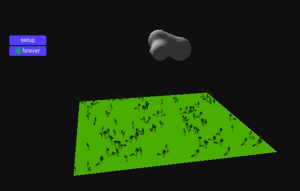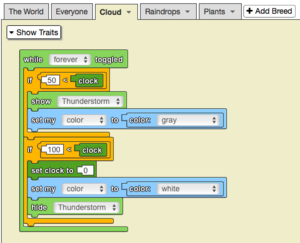Set Clock To/en: Difference between revisions
(Updating to match new version of source page) |
(Updating to match new version of source page) |
||
| Line 23: | Line 23: | ||
[[File:set_clock_to_example.gif|alt=Set Clock To example gif|thumb]] | [[File:set_clock_to_example.gif|alt=Set Clock To example gif|thumb]] | ||
[[File: | [[File:clock_example.png|alt=Set Clock To example code|thumb]] | ||
The model above depicts flowers growing with the rainfall over time. The clock is used to determine when thunderstorms start and stop: it will rain between 50 and 100, after which the clock will be reset to 0. In all, there are 50 ticks of rain followed by 50 ticks of no rain. | The model above depicts flowers growing with the rainfall over time. The clock is used to determine when thunderstorms start and stop: it will rain between 50 and 100, after which the clock will be reset to 0. In all, there are 50 ticks of rain followed by 50 ticks of no rain. | ||
Latest revision as of 15:59, 16 August 2023
Sets the value of clock to some number. Typically, when you reset the clock, you want to start it at 0.
set clock to [_] is a code block part of the Environment drawer.
Usage
set clock to [_] sets the value of clock to some number. Typically, when you reset the clock, you want to start it at 0.
Syntax
Inputs:
- a number
Common Uses
This is commonly used to reset the clock, which is helpful for each time you run a simulation.
Example
The model above depicts flowers growing with the rainfall over time. The clock is used to determine when thunderstorms start and stop: it will rain between 50 and 100, after which the clock will be reset to 0. In all, there are 50 ticks of rain followed by 50 ticks of no rain.



